INTRODUCTION
The interest in search for alternative/additional feed ingredients is of paramount importance in developing countries, mainly, because of the acute shortage of traditional feed materials. Introduction of saline agriculture production systems in salt affected regions has proved to be an effective way to save fresh water for human and animal consumption while the saline water could be used for animal feed production (Anon, 2009 and El Shaer, 2010). Several salt tolerant plant species have been introduced in South Sinai Governorate to be grown in saline soils and irrigated with saline ground water (Anon, 2006). Pearl millet (Pennisetum americanum), Atriplex nummelaria (saltbush), Leucaena leucocephala and Panicum turgidum are characterized by high salt tolerance, high vegetative yields and could have great potentialities, particularly, as sources of livestock fodders (El Shaer, 2006; Anon, 2009 and Fahmy et al., 2010). These forages are, also, drought tolerant and could be a feasible solution to minimize the problems of feed and fresh water shortage especially in arid and semi-arid regions (Ben Salem et al., 2002 and El-Shaer, 2006). Many studies have been conducted on utilization of Atriplex nummularia and Pear millet as individual fodder crops but few ones were carried out on utilization of a combination or a mixture of salt tolerant fodders as small ruminants feed materials (Gutteridge and Shelton, 1994; Arunachal et al., 2002; Ben Salem et al., 2002 and El-Shaer, 2006).
The present study aimed at evaluation of palatability, nutritive quality and nutritional performance of goats fed four salt-tolerant plants: Pearl millet (Pennisetum americanum) as a sole diet ormixed with each of saltbush (Atriplex nummularia), leucaena (Leucaena leucocephala) and Panicum (Panicum turgidum).
MATERIALS AND METHODS
Experimental Forages
The study was carried out at South Sinai Research Station, Desert Research Center, South Sinai Governorate, Egypt in April to July 2011.
Four salt-tolerant were separately cultivated in the salt-affected soil of the Research Station Farm and irrigated with underground saline water. They were namely: Pearl Millet (local strains, shandweel grass), (Pennisetum americanum), Atriplex nummularia (Saltbush, Old man), Leucaena leucocephala and Panicum turgidum. The soil was characterized by loamy sand texture where EC was approximately 10 ds/m depicting it as strongly saline. The CaCO3, Cl, Na, Ca, Mg and K concentrations were 40, 42, 11.6, 15.2, 10.8 and 7.5 mg/100 mg, respectively. The chemical analysis of irrigation water was characterized by 7.22 PH, 14.3 EC (ds/m), 191 Na+ (mg/L), 20.5 Ca++ (mg/L), 23.0 Mg++ (mg/L), 0.43 K+ (mg/L), 95.9 Cl‾(mg/L), 3.2 HCO3‾ (mg/L), 0.40 CO3‾ (mg/L) and 43.5 hardness.
Each forage species was harvested individually and total yield was determined (on fresh and dry matter basis, ton/ ha/ season). Each harvested forage crop was mechanically chopped into small pieces (ranged from 3-5 cmlength) to be offered to animals.
Experimental Animals
The study was consisted of a palatability trial (120 days) followed by a digestibility trial (15 days). Twenty-eight Black Desert male goats (averaged ten months old with 21.38±0.554 kg live body weight) were treated for internal and external parasites. The experiment was a completely randomized design with animal feeds as treatments.
Palatability Trials
During the palatability trial, animals were divided randomly by weight into four equal groups (7 animals each) and offered one of the following rations as follow:
G1: Pearl millet (PM)
G2: Pearl millet (PM) + Atriplex numularia (AN)
G3: Pearl millet (PM) + Leucaena leucocephala (LL)
G4: Pearl millet (PM) +Panicum turgidum (PT)
Each forage plant was offered daily ad-libitum, allowing a 15% refusal of each forage, while the concentrates (barley grains) was offered to all animals. Each goat group was housed in an individual shaded pens and offered the dietary forages in separate feeders plus the recommended amount of barley grains to cover 25% of their maintenance requirements (according to the recommendations of Kearl, 1982). Barley grains contained: 95.7 DM, 96.8 OM, 9.23 CP, 4.96 CF, 2.28 EE, 3.25 ash, 80.3 NFE, 18.5 ME, Mcal/kg DM, 2.88 NDF, 7.21 ADF, 11.3 hemicellulose,81.5 C.CHO, 0.693 Sodium and 0.560 Potassium (as % DM basis).
The daily voluntary feed intake (VFI) ofeach forage was determined for each animal/group. Representative samples from each offered forage and refusals were collected, oven dried and kept for chemical analyses. During the palatability trial, animals were weighed biweekly and nutrients requirements were adjusted according to live body weightchange. Drinking water was available for animals. Body weight changes were recorded for each animal.
Digestibility Trial
At the end of the palatability trial, three animals from each group were selected for the digestibility trial (15 days adaptation period followed by a 7-day collection period). They were kept in separate metabolic cages and offered 90% of their VFI of fodder crops (determinedat end of the palatability trial). Measured amounts of drinking water were available for each animal daily. Accurate records were kept for feed and water intakes and animal excreta during the collection period. The composite samples of feed offered, refusals and feces were dried, ground and kept for chemical analysis. Urine was, also, individually collected, sampled and stored for nitrogen analyses. By the end of collection period, rumen liquor was sampled before feeding (0 hr.) and 6 hours post feeding for immediate analyses.
Analytical Methods
Chemical composition of feeds residues, faeces and urine were determined (A.O.A.C., 1997). The fiber fractions (neutral detergent fiber, NDF) and acid detergent fiber, ADF) were applied by Goeringand (Van Soest, 1970). Hemicellulose values were calculated. Converted carbohydrate content (C.CHO) was calculated (100-NDF %). Rumen total volatile fatty acids (TVFA's) were tested (Warner, 1964) and rumen ammonia-nitrogen values were, also, evaluated (A.O.A.C., 1997). Sodium (Na) and potassium (K) concentrations were determined in feed offered and refusal, feces, urine and drinking water by using the standard flame photometry (Jackson, 1958).
Statistical Analysis
The data were subjected to the statistical analysis system according to (SAS, 1998). Differences in mean values between groups were compared by (Duncan's multiple tests, 1955).
RESULTS AND DISCUSSION
Chemical Composition
Considerable variations were observed among the chemical composition of the studied forage plants (Table 1). L. leucocephala attained the highest content of crude protein (CP). (Quansah and Makkar, 2012) recommended that forages containing CP ≥16% are very good, >8 and <16% are good and ≤8% are fair based on a minimum CP of 15-18% for adequate growth in ruminants. So, CP content of the studied forage species is categorized into three groups where L. leucocephala was categorized as very good sources of protein (16.64%), A. nummularia was categorized as good (12.16%) while, P. turgidum and Pearl millet (P. americanum), as grasses, were considered as fair (being 7.26 and 7.18%, respectively). The low CP contents of these grasses were lower than the maintenance requirements for ruminants as recommended by (Norton, 2003) who concluded that feeds contain less than 8% CP could not provide the ammonia levels required by rumen microbes for optimum activity and suggested supplementation of such forages with appropriate nutrients to achieve high level of animal production. L. leucocephala followed by the two grasses attained greater content of organic matter (OM) compared to A. nummularia (saltbush) which was characterized by high concentrations of ash and Na (25.9 and 1.92%, respectively). The fiber contents (NDF, ADF, Lignin, cellulose and hemicellulose) have implication on the digestibility of plants (El Shaer, 2010). The two grasses (P. turgidum and P. millet) contained the highest levels of NDF and ADF with the least contents of converted carbohydrates (C.CHO) in comparison with the other forage species. Atriplex nummelaria, as a halophytic shrub, showed the lowest OM, CF, EE, NFE, NDF, ADF, K and metabolizable energy values compared to other studied forages. These findings are in agreement with those reported for the same plant species by (Bassala et al., 1991; Garcia et al., 1996; Ramirez et al., 2000 and Kanani et al., 2006). It appeared that L. leucocephala is a protein and energy-rich fodder crop that could play an important role in providing a balanced diet to small ruminants in salt affected regions (Odedire and Babayemi, 2007). Such figures and trends are compatible with those reported by (Bamikole et al., 2004, Youssef et al., 2009 and Abdou et al., 2011).
Table (1). Chemical composition of the salt tolerant forages (as %, DM basis).
1Metabolizable energy: ME, M cal/ kg DM (Church and Pond, 1982).
P. americanum: Pearl Millet (PM) A.nummularia: Atriplex nummelaria (AN)
P. turgidum: Panicum turgidum (PT) L.leucocephala: Leucaenaleucocephala (LL)
The Na and K contents of forages were, generally, still within the acceptable range for ruminant performance (NRC, 2007). For instances, minimum concentrations of sodium in the diet were recommended to be 0.7- 0.9 g/kg DM for sheep, 0.5% of the complete feed for goats with a significant variation between animal species, breeds within species, and maturity status (NRC, 2007).
Forage Crop Yields
The forage yields, as fresh, DM, CP, TDN or DCP yield (ton / ha/ year, on average bases) of the four tested forages are presented in Table 2. It seems that all forages showed comparable amounts of DM yield (around 12 ton/ ha/ year), except of A. nummularia which attained the lowest yield (8 ton/ ha/ year). L. leucocephala exhibited the superior production of CP, TDN and DCP in comparison with the other forage species. It might be due, mainly, to its high content of protein (16.64%) and energy contents (2.46 ME, M cal/ kg DM). These findings supported those obtained by Babayemi and Bamikole (2006) and Odedire and Babayemi (2007). Both P. millet and P. turgidum, as grasses, attained comparable amounts of nutrients yields. Based on the recommendations of (Kearl, 1982) for the maintenance requirements of goats, it is assumed that one hectare of L. leucocephala could cover the maintenance requirements of 123 goats for a year while similar figures from P. turgidum and Pearl millet were 56 and 51 heads of goats, respectively if these forages will be offered to animals solely without any feed supplements. Therefore, it could be concluded that L. leucocephala could be a great potential salt tolerant fodder crop whereas the other forages should be mixed or supplemented with other feed materials.
Table (2). Nutrients yield of the cultivated salt-tolerant fodder crops (onaverage basis, ton/ ha/ year).
*Number of goats that could be raised on1 haof fodder crop/ year
Palatability Trial
1. Voluntary Feed Intake of Salt-tolerant Plants
The amounts of voluntary feed intake (VFI, gDM /h/d) of all forage crops were increased gradually during the palatability period (Table 3). Such increments were achieved at various proportions among the plant species, indicating that the animals accepted these forage species at various degrees. The rate of increments started to be declined at the 10th week of the trial as the VFI values became, to some extents, constant. The highest values of total forages consumption were recordedfor animals fed P. Millet mixed with L. leucocephala in G3 (1428g DM/h/d) followed by those fed P. millet plus P. turgidumin G4 (1177gDM/h/d) due to great intakes of L. leucocephala in G3 and P. turgidum in G4. The lowest VFI value was recorded for animals fed P. millet as a sole diet in G1 (454 g DM/h/d). Palatability of A. nummularia was the least at the beginning of the trial but it was improved greatly when was offered in a combination with P. millet in G2. It seems that addition of P. millet showed positive associated effects on the saltbush intake with a significant increase in its palatability (around 170% increment rate) at the 10th week of the palatability trial. It was obvious that, from Table 3 and Figure 1, the low intake of P. millet (as a sole diet) could be attributed to its low CP content. Adequate amounts of protein and energy are required to properly balance forage based diets for ruminants (Leng, 1990 and Norton, 2003). This is especially true when low quality forages, such as P. millet, forms majority of the diet (G1 and G2, based on the selectivity ratio). Voluntary feed intake declined in forages containing less than 7% CP (NRC, 2007). The improved VFI of L. leucocephala (G3) and P. turgidum (G4) could be attributed to a high CP content, a faster rumen outflow rate and the provision of more degradable organic matter (Aregheoreet al., 2004; Yousufet al., 2007 and Fasae et al., 2011). The level of CP is known to influence intake of forages, and therefore for optimum rumen function presence of adequate amount of protein in the diet is a must (Lazzarini et al., 2009). Therefore, it is imperative to balance the diets of goats in terms of protein and energy through mixing more than one fodder crops that will improve the palatability and intakes as compared with feeding the plant alone.
Table (3). Voluntary feed intake of fodder crops (gDM/h/d) and selectivity ratio (%) for goats during the palatability trial.
G1: P. millet (PM), G2: P. millet + A.nummelaria (AN), G3: P. millet + L. leucocephala (LL),G4: P. millet + P.turgidum (PT)
Figure (1): Voluntary feed intake of fodder crops during the palatability trial.
Data of body weight changes, daily gain and total VFI in terms of DM, CP and OM (from each forage species or total diets) during the palatability trial (120 days) were significantly (P≤0.05) varied among the animals groups (Table 4). Goats fed P. millet mixed with L. leucocephala (G3) showed the maximum values (P≤0.05) of total DMI, CPI, OMI that were exceeded by approximately 140, 343 and 140%, respectively than those of G1 (P. millet solely). Goats fed P. millet mixed with P. turgidum attained significantly (P≤0.05) the second order. The trends of DM, CP and OM intakeswere significantly (P≤0.05) reflected on the pattern of live body weight changes since animals exhibited positive various (P≤0.05) body weight gain. Animals of G3 revealed the highest significant values of body weight changes (approximately 6 kg) and average daily gain (around 55g/h/d). These results are in closed agreement with those reported by (Kanani et al., 2006 and Otukoya and Babayemi, 2008) who found that highest live weight gain by goats fed on L. leucocephala may be due to their significant total intake of DM and CP. The authors reported that goats that have been adapted to the high consumption of L. leucocephala often result in appreciable weight gain. It is clear to mention that legume supplementation has been observed to improve animal performance (Osakwe, 2006). The author, also, indicated that goats supplemented with browse legumes had higher body weight gains, suggesting that the various browse legumes had beneficial effects on the animals. The present findings agree with those found by (Yousuf et al., 2007) who pointed out that higher dry matter intake is often associated with increased protein intake, resulting in faster rates of passage of diets through the gastro-intestinal tract. The improved feed intake for L. leucocephala supplemented diets (G3) could have resulted due to faster rumen outflow rate and the provision of more degradable organic matter (Mtenga and Shou, 1990).
Table (4). Voluntary feed intake (g DM/h /d) and body weight changes of goats at the end of the palatability trial (120 days).
G1: P. millet (PM), G2: P. millet + A.nummelaria (AN), G3: P. millet + L. leucocephala (LL),G4: P. millet + P.turgidum (PT)
a, b, c, d Means with different superscripts in the same row differ significantly (P < 0.05), otherwise no significant differences were detected.
Digestibility Coefficients and Nutritive Values
Data in (Table 5) indicated that consumption of dietary forages was varied (P≤ 0.05) significantly. The highest values of consumption was recorded by animals fed P. Millet and L. leucocephala (G3) followed by those in G4 then G2 while the lowest one was recorded for animals in G1 ( P. millet solely). High DM intake in G3 may be due to L. leucocephala leaf supplemented diets. Mixing more than one forage with L. leucocephala would improve the palatability; thus a significant increase in daily total dry matter intake would be occurred as compared with feeding one forage grass alone (Fasae et al., 2011). The low DM intake in goats (G1) could be attributed to the low nutrient contents (Table 1) of P. millet (Adebowale, 1985 and Fasae et al., 2011) therefore, it is imperative to balance animal diets in terms of essential nutrients through supplementation with leaves of browse trees such as L. leucocephala.
Table (5) Digestibility coefficients and nutritive values of goats fed the experimental rations.
G1: P. millet (PM), G2: P. millet + A.nummelaria (AN), G3: P. millet + L. leucocephala (LL),G4: P. millet + P.turgidum (PT)
a, b, c, d Means with different superscripts in the same row differ significantly (P < 0.05), otherwise no significant differences were detected.
Digestion of all nutrients was varied significantly (P≤ 0.05) among the four dietary groups as affected by the type of diets (Table 5). It seems that all goats in G1, G3 and G4 tended to digest OM, DM and C.CHO at the same degrees without significant differences but higher (P≤ 0.05) that those reported in G2. Crude protein was efficiently (P≤ 0.05) more digested (58.18%) by Goats in G3 compared to those in the other dietary groups. It might be attributed to high content of CP in L. leucocephala (Oldham and Alderman, 1980). The worst CP digestion (44.43%) was recorded by animals fed P. millet as a sole diet (G1). Crude fiber digestion and all fiber constituents were varied significantly (P≤ 0.05) among animal groups. It appeared that goats fed diets containing grasses in G4 and G1 tended to digest crude fiber and fiber constituents much better (P≤ 0.05) as reported by Aregheore et al. (2004) and Fahmy et al. (2010).
The nutritive values of the tested diets, expressed as total digestible nutrients (TDN) and digestible CP (DCP) values, were significantly (P≤ 0.05) affected by the types of fodder crops (Table 5). DCP intake was the highest (P≤ 0.05) for the diet of goats in G3 (3.45 g/ Kg BW). Similar pattern was recorded for TDN values (g/kg BW) where the highest value (P≤ 0.05) was exhibited by animals in G3 (25.35 g/Kg BW). Such superiority might be due to both high DMI and CP content of L. leucocephala (Oldham and Alderman, 1980).
Rumen Parameters
Data of rumen ammonia-nitrogen and total volatile fatty acids (Table 6) revealed that there was a significant (P≤ 0.05) increase in ammonia-nitrogen values with increasing the time before feeding (0 time) up to 6 hours after feeding for all animal groups. It was clear that goats in G3 recorded the highest significant ammonia-nitrogen value (55.45 mg/100ml) compared to the other experimental groups. This is may be due to high content of CP in leucaena fed to animals in this group (Norton, 2003). Similar trends were obtained for total volatile fatty acids (TVFA's ) concentrations where animals in G3 showed the greatest values being (33.16meq/100ml) followed by those in G4 (26.9meq/100ml). It might be a reflection to rich energy and organic matter contentsin leucaena (ME: 2.46 Mcal/KgDM and OM: 90.7%, respectively) as previously shown in Table 1. Such results are in agreement with those reported by (Mahanta et al., 1998). Feeding Leucaena leucoephala to small ruminants provided higher concentrations of rumen metabolites which naturally improved rumen function and digestibility (Bonsi et al., 1995).
Table (6). Ammonia- nitrogen (NH3-N, mg/100ml) and total volatile fatty acids (TVFA's, meq/100ml) of goats fed the experimental fodder.
a, b, c, d Means with different superscripts in the same row differ significantly (P < 0.05), otherwise no significant differences were detected
Nitrogen Utilization and Minerals Balance
Results on nitrogen intake (NI), excretion, balance and digested N (% of intake) were significantly (P≤0.05) varied among the animals groups as affected by the type of fodder diets (Table 7). All animals fed the different diets showed positive N balance and retained significant (P≤0.05) various amounts of N. Goats in G3 exhibited the highest values (P≤0.05) of nitrogen intake, total excretion and nitrogen balance. Such findings are very correlated with those obtained during the palatability trial (120 days) where animals gained appreciable various BW gain. Similar trends are reported by (Otukoya and Babayemi, 2008) who found that N intake, retention and total excretion by goats increased with increasing leucaena in the diets.These results are conformity with some other studies on sheep and goats fed similar feed materials (Aregheore et al., 2004; Yousuf et al., 2007 and Otukoya and Babayemi, 2008).
Table(7). Nitrogen (N), Sodium (Na) and Potassium (K) utilization (g/kg BW) of goat fed the experimental forages.
a, b, c, d Means with different superscripts in the same row differ significantly (P < 0.05), otherwise no significant differences were detected.
Data on Na and K utilization (Table 7) revealed that valuesof Na intake and Na excretion and balance (g/kg BW) were significantly (P≤0.05) varied among the experimental groups. All animals were in positive Na and K balance and retained various amounts (P≤0.05) of both minerals. The highest significant (P≤0.05) Na intake was recorded for goats in G4 due mainly to high Na concentration in P. turgidum (1.62%, Table 1). The same animal group (G4) tended to retain the greatest amount of Na (0.31 g/kg BW). Goats in G3 showed the highest (P≤0.05) significant Kintake due to high K concentration in both P. millet and L. Leucaena (Table 1) and total dietary intake as well. The animals (G3) retained the greatest (P≤0.05) amount of K (0.38 g/kg BW) in comparison with the other animal groups. Similar patterns are, generally, reported by McDowell and Arthington (2005) and Youssef et al. (2009).
Water Utilization
Data of Table (8) showed that water intakes (in terms of drinking, combined and metabolic water) were varied (p≤0.05) significantly among animal groups. However, goats in G2, G3 and G4 tended to consume comparable amounts of water without significant differences. The least amount of water consumption was recorded for goats in G1. High consumption of water in G4 and G3 may be due to increasing of fodder crops intake and high content of ash in Atriplex fed to goats in G2. These results conformity with (Mtenga and Shoo, 1990). On the other hand, no significant difference was noticed in urinary water of all experimental groups. These findings are in agreement with (Eid, 2003 and Allam et al., 2006) on animals fed similar dietary rations. They reported that feeding animals salt tolerant fodders of high ash content led to push animals to increase excretion of urine. Water balance was higher (P≤ 0.05) in G4 followed by G3 and the lowest value was recorded in G1 which mainly attributed to the pattern of water consumption and total water intake (Eid, 2003 and Youssef et al., 2009).
Table (8) Water balance (ml/kgBW) of goats fed the salt tolerant fodders.
a, b, c, d Means with different superscripts in the same row differ significantly (P≤ 0.05), otherwise no significant differences were detected.
CONCLUSION
Pearl millet mixed with Leucaena leucocephala or with Panicum turgidum can be successfully used as potential fodders for small ruminants in salt affected regions such as in South Sinai, Egypt.
ACKNOWLEDGEMENTS
This work was supported by the International Center for Bio-saline Agriculture (ICBA), Dubai, UAE under the framework of the technical cooperation project entitled "Adaptability to climatic changes in marginal environments in the West Asia North Africa through the sustainable diversity of crops and animals”.
REFERENCES
Abdou.Ahlam R., E.Y. Eid., Abeer M. El-Essawy, Afaf M. Fayed., H.G. Helal and H.M. El Shaer (2011). Effect of Feeding Different Sources of Energy on Performance of Goats Fed Saltbush in Sinai Journal of American Science. 7(1); 1040-1050.
Adebowale, E.A., (1985). Response of sheep and goats fed maize straw treated with local alkali. Nigerian Journal Animal Production 12; 137-140.
Allam, Sabbah M., K. M., Youssef, Ali, M. A. and S. Y., AboBakr (2006). Using some fodder shrubs and industrial by products in different forms for feeding goats in Sinai. J. Agric. Sci. Mansoura Univ., 31(3): 1371-1385.
Anon (2006). Electronic Conference on salinization: Extent of salinization and strategies for salt-affected land prevention and rehabilitation, 6 February-6 March 2006. Organized and coordinated by IPTRID (International Programme for Technology and Research in Irrigation and Drainage), FAO.
Anon (2009). Introduction of salt-tolerant forage production systems to salt-affected lands in Sinai Peninsula inEgypt: a pilot demonstration project. Final Report, DRC, Egypt-ICBA, UAE.
A.O. A. C. (1997). Official Methods of Analysis. 16 th Ed. Assoc. Offic. Anal. Chem.,Arlington,VA.
Aregheore, E.M., D., Perera and M.S., Yahaya (2004). Nutritive Value of Batiki Grass (Ischaemumaristatum var. indicum) Supplemented with Leaves of Browses (Gliricidiasepium and Leucaena leucocephala) on Performance of Goats. International Journal of Agriculture and Biology. 6(1):43-148.
Arunachal, P.K., K., Karunanithi, and R., Narendrababu, (2002). Comparative study on anthelmintic efficacy of neem products and praziplus in sheep. Indian J. Small Ruminant. 8, 131-132.
Babayemi, O. J., and M. A., Bamikole (2006). Supplementary value of Tephrosia bracteolata, Tephrosia candida, Leucaena leucocephala and Gliricidia sepium hay for West African dwarf goats kept on range. Journal of Central European Agriculture. 7 (2): 323-328.
Bamikole, M.A., U.J. Ikhatua, O.M. Arigbede, O.J. Babayemi andI., Etela, (2004). An Evaluation of the acceptability as forage of some nutritive and anti-nutritive components and of the dry matter degradation profiles of five species of Ficus. Tropical Animal Health and Production. 36,157-167.
Bassala, P., P., Felker, and D.H.D., Swakon (1991). A comparison of Leucaena Leucocephalaand Leucaena pulverulenta leaf and stem age classes for Nutritionalvalue. Trop. Grasslands. 25, 313-316.
Ben Salem, H., A., Nefzaoui, and L., Ben Salem (2002). Supplementation of Acacia Cyanophylla Lindl. Foliage-based diets with barley or shrubs from arid areas (Opuntiaficusindica F. inermis and Atriplex nummularia L.) on growth and digestibility in Lambs. Animal Feed Science and Technology.96 (1), 15-30.
Bonsi, M. L. K., P. O., Osuji, and A. K., Thuah, (1995). Effect of supplementing straw with different level of Leucaena or sasbania on the degradability of tef straw, sesbania, leucaena, tagaste and vernonia and certain rumen and blood metabolites’ in Ethopianmenz sheep. Anim. Feed Sci Technol. 52, 101-129.
Church, D. C. and W. G. Pond (1982). Basic animal nutrition and feeding, 2 nd ed. Johnwiley and sons,New York,U. S. A.
Duncan, D. B. (1955). Multiple ranges and multiple F tests. Biometrics.11, 1-42.
Eid, E. Y. A., (2003). Feed utilization and performance of animal fed the natural and cultivated fodder shrubs in Sinai. Ph D. Thesis, Fac. of Agric. Cairo Univ. Egypt.
El Shaer, H. M., (2010). Halophytes and salt tolerant plants as potential forage for ruminants in the Near East region. Small Ruminant Res. 91; 3- 12.
El Shaer, H.M., (2006). Halophytes as cash crops for animal feeds in arid and semi-arid regions. In: Ozturk, M., Waisel, Y., Khan, M.A., Gork, G. (Eds.), Biosaline Agriculture and High Salinity Tolerance in Plant. Birkhauser,Basel, pp. 117-128.
Fahmy A.A., K.M. Youssef and H.M. El Shaer (2010). Intake and nutritive value of some salt-tolerant fodder grasses for sheep under saline conditions of South Sinai,Egypt. Small Ruminant Research. 91; 110-115.
Fasae O.A., Adesope, A.I., Ojo V.O.A. (2011). The effect of Leucaena leaf supplementation to maize residues on village goat performance. Journal of Animal & Plant Sciences. 10 (2); 1276-1282.
Garcia, G.W., T.U. Ferguson, F.A. Neckles and K.A.E.Archibald (1996). Thenutritive value and forage productivity of Leucaena leucocephala. Anim. Feed Sci.Technol. 60; 29-41.
Goering, H.K. and P.J. Van Soest (1970). Forage fiber analysis. Agricultural Handbook, No. 379, USDA, Washington. DC,USA.
Gutteridge, R.C. and H.M. Shelton (1994). Forage Tree Legumes in Tropical Agriculture. CAB International, UKp389.
Jackson, M.L., (1958). Soil Chemical Analysis. Constable and Company, Ltd, England.
Kanani, J., S.D. Lukefahr and R. L. Stanko (2006). Evaluation of tropical forage legumes (Medicago sativa, Dolichos lablab, Leucaena leucocephala and Desmanthus bicornutus) for growing goats. Small Ruminant Research. 65, 1-7.
Kearl, L.C., (1982). Nutrient requirements of ruminants in developing countries. Utah Agric. Exp. St., Utah State Univ.Logan, UT,USA.
Lazzarini,I., E. Detmann and C.B. Sampaio (2009). Intake and digestibility in cattle fed Low- qualities tropical forage and supplemented with nitrogenous Compounds. Revista Brasileira de Zootecnia. 38(10); 2021-2030.
Leng R.A., (1990). Factors Affecting the Utilization of 'Poor-Quality’ Forages by Ruminants Particularly Under Tropical Conditions. Nutrition Research Reviews. 3; 277-303.
Mahanta, S.K., S. Singh, A.Kumar, Pachauri, V.C. andA.K. Pokhama (1998). Effect of subabul leaf meal on rumen profile, wool yield and its quality in lams. Indian J.Anim. Nutr. 15: 48-51.
Mtenga, L. and R. Shuo (1990). Growth rate, feed intake and feed utilization of small East African goats supplemented with Leucaena leucocephala. Small Ruminant Research. 3: 9-18.
Norton, B.W., (2003). The Nutritive value of tree legumes. In: Forage Tree Legumein Tropical Agriculture, Gutteridge R.C and Shelton H.M, (eds). pp.43
NRC., (2007). Nutrient Requirements of Small Ruminants: Sheep, Goats, cervids, and New Worldcamelids. National Academy Press, Washington DC, USA.
Odedire, J. A. and O. J. Babayemi (2007). Preliminary study on Tephrosia candida as forage alternative to Leucaena leucocephala for ruminant nutrition in Southwest Nigeria. Livestock Research for Rural Development 19 (9) http://www.lrrd.org/lrrd19/9/oded19128.htm.
OldhamJ.D. and G. Alderman (1980). Recent advances in understanding protein energy interrelationship in intermediary metabolism in ruminants. In; protein and energy supply of high production of milk and meat. Pergamann Press,Oxford. Pp. 33.
Osakwe, I.I. (2006). Effects of Leucaena leucocephala supplementation to basal hay on energy and protein metabolism in West African Dwarf sheep. Nigerian Journal Animal Production. 33 (1); 94-101.
Otukoya F. K. and O. J. Babayemi (2008). Supplementation of Leucaena leucocephala hay as protein enrichment for cassava peels in West African dwarf goats. Journal of Food, Agriculture & Environment .6 (2); 247-250.
Quansah, E.S. and H.P.S.Makkar (2012).Use of lesser-known plants and plant parts as animal feed resources in Tropical regions. Animal Production and Health Working Paper. No. 8, FAO, Rome.
Ramirez, R.G., R.R. Neira-Morales, R.A. Ledezma-Torres andC.A., Graribaldi-Gonzalez, (2000). Ruminal digestion characteristics and effective degradability of cell wall of browse species from northern Mexico. Small Ruminants Res. 36; 49-55.
SAS, (1998). SAS user guide: statistics version 5 edition, SAS institute inc.,Cary,NC.
Warner, A.C.J. (1964). Production of volatile fatty acids in the rumen methods of Measurements Nutr. Abst. and Rev. 34: 339.
Youssef K.M., A.A. Fahmy, Abeer M. El-Essawy and H.M. El Shaer (2009). Nutritional study on Pennisetum americanum and kochia indicafed to sheep under saline conditions ofSinai,Egypt. Journal of American Science. 5(1); 63-68.
Yousuf, M. B., M A. Belewu, H. A. Gbadamosi and N. I. Ogudun (2007). Replacing Cotton Seed Cake with Cassava Leaf Meal in Corn Bran Based Diet Fed to the Goat. Bulgarian Journal of Agricultural Science. 13; 231-236.
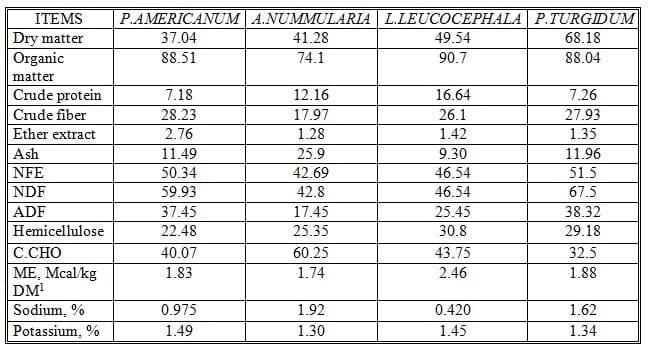


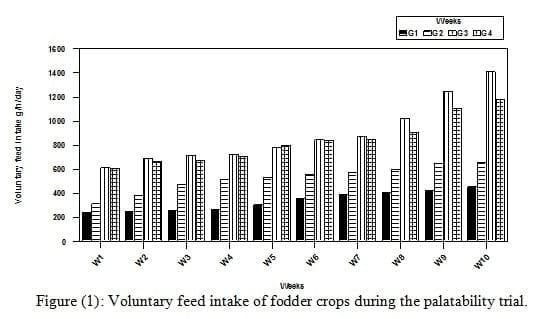
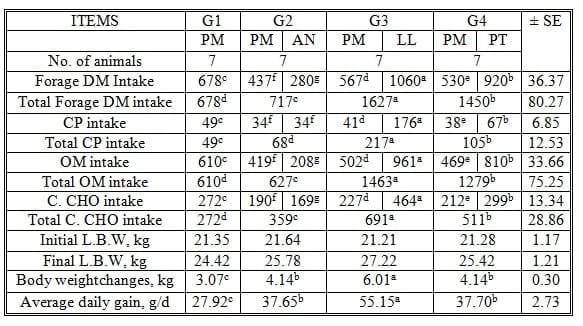

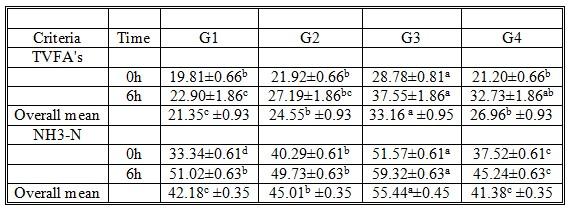
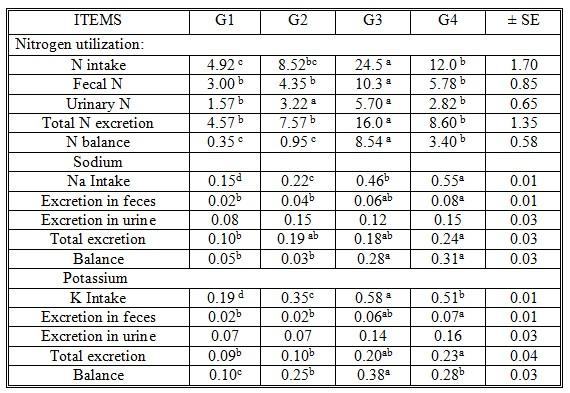
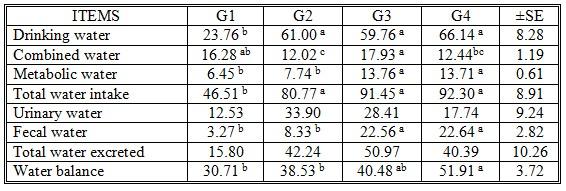







.jpg&w=3840&q=75)